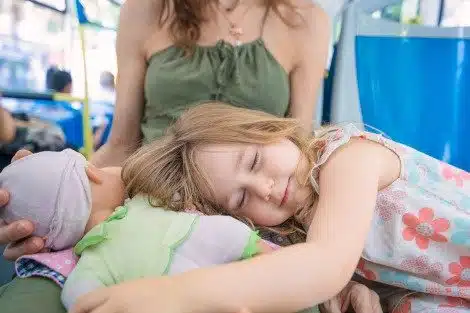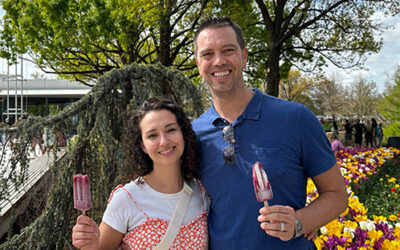“I’m a single mom to a two-year-old girl, and ever since she was born, it’s been a struggle to pay bills and make sure she has everything she needs. I didn’t have any support from my parents, and her dad disappeared when he learned I was pregnant. The only time I see my daughter is when I drop her off at daycare in the morning and pick her up at night. I want her to have better than this. It breaks my heart to have to admit this, but I’ve Googled, “putting toddler up for adoption” and “can you give an older child up for adoption?”
If you’re searching for information about adoption, it means that you love your child so much that you want the very best for them. No matter what you’re going through, please know you’re not alone.
Lifetime often hears from moms who don’t have enough money to cover the costs of several children. Others cannot care for their child because of a sudden illness or incarceration. Adoption may be one solution to consider, but it’s important to understand all your options before making this permanent decision.
The phrase “put up your child up for adoption” isn’t used much today. Instead, most birth mothers explain adoption as “placing their child” in adoption. After all, adoption isn’t “giving up” on anything; it’s about making the thoughtful decision to place your child with loving and ready adoptive parents.
Table of Contents
- Understanding Your Options
- Why Do Women Choose Adoption?
- What is Open Adoption?
- What Choices Do I Have With Open Adoption?
- What is the Process for Putting My Child for Adoption?
- Helpful Resources
- Lifetime is Here to Help You Make an Informed Decision
Understanding Your Options
Adoption allows you to choose a loving family for your child while opening new possibilities for your own future. It also fulfills the dreams of an adoptive family who has been hoping to welcome a child into their lives.
But before considering adoption, it’s important to explore available support systems and resources that might address the challenges you’re facing:
Financial Assistance Programs:
- Temporary Assistance for Needy Families (TANF)
- Supplemental Nutrition Assistance Program (SNAP)
- Women, Infants, and Children (WIC) program
- Housing assistance programs
- Childcare subsidies
- Utility assistance programs
Family Support Services:
- In-home support services
- Parenting classes and support groups
- Counseling and mental health services
- Substance abuse treatment programs
- Domestic violence support services
Community Resources:
- Local churches and community organizations
- Food banks and clothing assistance
- Transportation assistance
- Educational support and job training programs
Why Do Women Choose Adoption?
Some women contact us because they’re in situations where, even with available supports, they believe adoption may be in their child’s best interest. These situations might include:
- Serious Safety Problems: When there is violence in the home or other dangers that can’t be fixed while keeping the family together
- Health Issues: When a parent is very sick and will die, or has a disability that makes it hard to take care of children, and no other family members can help
- Drug or Alcohol Problems: When a parent keeps using drugs or alcohol even after trying to get help, and this puts the child in danger
- Mental Health Issues: When a parent has very serious mental illness that doesn’t get better with treatment and makes it hard to be a good parent
- Going to Jail: When a parent has to go to prison for a long time and there are no family members who can take care of the child
- Finances: With other children in their home, there’s just not enough money to provide for all of them, despite accessing available assistance programs
These personal challenges don’t automatically mean adoption is necessary. Working with a licensed clinical social worker or counselor can help you explore whether these challenges might be addressed while keeping your family together.
What is Open Adoption?
Simply put, it’s an adoption process in which both the birth mother (or birth parents) and the adoptive family meet before, during, and after the adoption. With open adoption, you can choose your child’s parents and stay in touch in the future. Your child won’t end up getting lost in the foster care system. A big part of open adoption is that there is an exchange of personal information, discussions about adoption plans, and how best to raise the child.
When you choose an open adoption, you can make the choices you want for your child rather than someone else. You won’t have to wonder if your child is safe and cared for the way you would like.
Open adoption allows you the opportunity to be part of your child’s life throughout their growing-up years. You can get pictures and updates, and even have in-person visits with the adoptive family. Birth mothers at Lifetime Adoption are in control of their own adoption plan.
What Choices Do I Have With Open Adoption?
Unlike a closed adoption, an open adoption gives you many choices throughout the process. Open adoption allows you to:
- Pick your child’s adoptive parents
- Choose how you want the transition period to go
- Decide what kind of future contact you want with your child
Your Child’s Adoptive Parents
With open adoption, you choose the adoptive parents you feel would be the best to raise your child. Your Adoption Coordinator can send you links to adoptive family profiles online, or you can begin finding an adoptive family right here on our website.
Each adoptive family’s website includes pictures of the family and information about what they like to do. Most of their websites also have a video of the adoptive couple introducing themselves and giving you a glimpse into what life might be like for your child with their family.
After you choose a couple of your favorite adoptive parents, your Adoption Coordinator will arrange for you to meet with the family to learn more about them. When you speak with them, you can ask about their approach to discipline and education, and see if their values align with yours. If, after talking, you don’t think they’re the right parents for your child, you go back to the profiles and keep looking.
How the Transition Happens
The adoptive family you choose will travel to your town to spend time with you and your child or children in an open adoption. When you all decide you wish to move forward with an adoption, you are considered “matched.” Your Lifetime coordinator is still walking with you every step of the way.
An attorney and counselor may be involved soon to create a transition plan for your child. Research from the Center for Adoption Support and Education recommends:
- 4-6 week transition periods for children over 2 years old, based on attachment research
- Daily visits gradually increasing in length before overnight stays
- Involvement of child therapists trained in adoption transitions
- Transition objects (favorite toys, blankets) to provide continuity
- Photo books introducing the adoptive family before meetings begin
- Consistent schedules to reduce anxiety during the transition
Future Contact With Your Child
One of the biggest advantages of open adoption is choosing what kind of contact you would like to have with your child as they grow up. Open adoption allows you to stay connected to your child through emails, texts, or phone calls. Some birth mothers become very involved with their child and the adoptive family.
Every open adoption looks different depending on what you and the adoptive family decide. The important thing is that having a certain level of openness will be beneficial for both you and your child.
Studies have found that birth mothers who had contact with their child and the adoptive family experienced less unresolved grief than those who had none. Having contact with your child and the adoptive family will help you in the days after your child goes to live with the adoptive family.
What is the Process for Putting My Child for Adoption?
Before beginning the process, here are some recommended first steps:
- Consult with a Licensed Clinical Social Worker who specializes in family preservation to explore all options
- Contact local family services to assess available support programs
- Seek counseling to process your feelings and explore decision-making
- Consider temporary solutions like kinship care while you address underlying issues
If you decide to move forward with adoption, Lifetime provides you with an Adoption Coordinator who will work one-on-one with you you move through the process. She is there to help you in any way they can with kindness and without judgment. Making an adoption plan for your child up gives you control and allows you to provide your child with the life you want them to have.
Your Adoption Coordinator will prepare you, so you know exactly what is going to happen. That way, there won’t be any surprises or uncomfortable last-minute decisions, making this adoption process a little easier for you to walk through. Here’s how adoption works:
1. Reach out to Lifetime
Call or text us to speak to a caring Adoption Coordinator that can help answer your questions about the adoption process for a child already born. Depending on your specific needs and situation, she can help you with the best approach. Every adoption is different.
She will also gather information about you and your child, like their age, development, health, interests, school progress, and general behavior. There are adoptive families open to adopting every child, and by gathering as much information from you, she will be able to help you in the best way possible.
2. Fill out paperwork
Your Adoption Coordinator will send some paperwork for you to complete, or you can complete the paperwork online. This paperwork gathers information; it’s not the final legal paperwork. It includes a health history and medical releases.
Your Adoption Coordinator will use the information to gather adoptive family profiles for you to consider. We can also schedule a time that you can speak with a counselor who can talk to you about your decision-making process and help as you prepare to transition your child to their new family. There is no charge for this, and it is a vital part of the adoption planning process.
3. Look at adoptive family profiles and choose the best parents for your child.
After looking at adoptive family profiles, you’ll need to choose two or three favorites. You can speak with them, which will help you decide and allow you to talk about what type of contact you would like in the future. All of the adoptive families that Lifetime works with are open to keeping in touch with you through letters, photos, email, texting, phone calls, social media, and even getting together once or twice a year for a visit.
You may have some questions about their lives and interests, and they may have some for you about you and your child. Many mothers also ask about their discipline approaches and educational values. If you prefer, your coordinator can be a part of the phone call, or you can start by texting with them.
4. Begin the Transition Period
Once you choose an adoptive family, they will travel to your town to spend time with you and your child or children. At first, you and your child will meet the adoptive family at a park or playground. The transition should be slow to help your child adjust easier. Regular check-ins are recommended to see how your child is adjusting, as is flexibility to slow the process if your child shows signs of trauma or difficulty.
During this transition time, you may meet with the attorney to learn about your rights and begin to complete the paperwork for the legal aspect of adoption. You may also want to schedule a time to speak with a counselor or a peer counselor.
You may want to write a letter to your child and gather some of his or her favorite things, like blankets or stuffed animals. After you have signed the final adoption paperwork, your child and chosen family will go to their home. You will have the time you need to say goodbye, knowing that this is not goodbye forever, but you will stay in touch.
Your Adoption Coordinator will be there for you throughout the adoption process, sending you free information and answering all your questions. You can reach her by phone or text for 24/7 counseling and a listening ear.
Helpful Resources
Here are some things you can do to cope with the many emotions you’ll experience after placing your toddler for adoption.
Get Counseling
Your Adoption Coordinator can connect you with a licensed counselor to meet with. These counselors are independent; they don’t work for Lifetime Adoption. She counselor can help you deal with your grief and reassure you that what you’re feeling is normal. She can also help as you move through the transition process.
Find Support
Get support from your family, trusted friends, or a support group of other birth mothers. You can also find support from one of Lifetime’s peer counselors. Connecting with someone who has placed their child for adoption can be very helpful.
You can ask her questions such as how she told her child’s father and how she picked a family. You may want to hear what her adoption experience was like. Her story may be different from yours, but she will understand how you feel and what your concerns are. Lifetime’s peer counselors are more than happy to share their adoption journeys with you.
Keep a Journal
Some birth mothers find writing out their feelings and thoughts in a journal helpful. Journaling can help you understand how you’re feeling and give you perspective as time goes on. In addition, this journal may be something you want to share with your child when they reach adulthood.
Give Yourself Time
Most of all, allow yourself time. After placing your child for adoption, dealing with all your feelings will take time.
Remember, it’s a process. There isn’t an exact timetable for how long it takes to cope with your grief. Don’t minimize your feelings of grief and sadness. Over time, you’ll feel better and be able to move forward in your life. Being able to see your child and get updates on how they’re doing will be helpful and healing to you.
Lifetime is Here to Help You Make an Informed Decision
We have experience helping women explore their options when facing parenting challenges, including adoption placement for children from newborn to seven years old. With open adoption, you choose your child’s parents and stay in touch with your child in the future.
Our Commitment to Informed Decision-Making:
- We connect you with independent counseling resources
- We respect your timeline and don’t pressure quick decisions
- We support whatever decision you make, even if it’s not adoption
Remember that loving your child includes thoroughly exploring whether there are ways to safely keep your family together with appropriate supports. Adoption may be the right choice in some situations, but it should be considered only after other options have been genuinely explored.
Our Adoption Coordinators are here to help you. We can answer your questions about choosing adoption for your child. Just call or text Lifetime at 1-800-923-6784 to chat with a caring adoption professional.
Editor’s Note: This article was originally published on March 27, 2018, and has since been updated.
As Vice President of Lifetime Adoption, Heather Featherston holds an MBA and is passionate about working with those facing adoption, pregnancy, and parenting issues. Heather has conducted training for birth parent advocates, spoken to professional groups, and has appeared on television and radio to discuss the multiple aspects of adoption. She has provided one-on-one support to women and hopeful adoptive parents working through adoption decisions.
Since 2002, she has been helping pregnant women and others in crisis to learn more about adoption. Heather also trains and speaks nationwide to pregnancy clinics to effectively meet the needs of women who want to explore adoption for their child. Today, she continues to address the concerns women have about adoption and supports the needs of women who choose adoption for their child.
As a published author of the book Called to Adoption, Featherston loves to see God’s hand at work every day as she helps children and families come together through adoption.







0 Comments